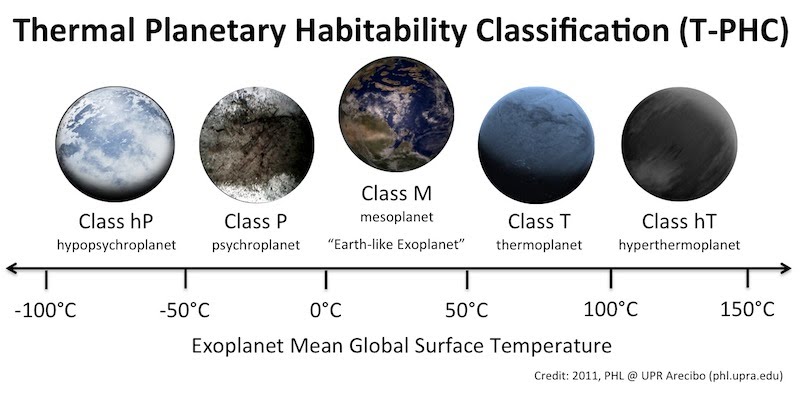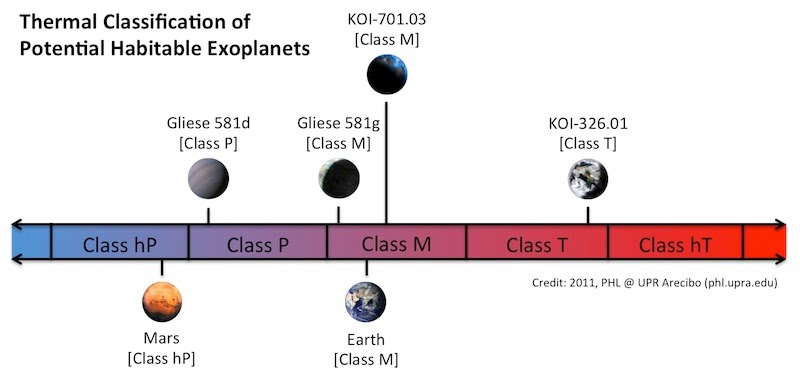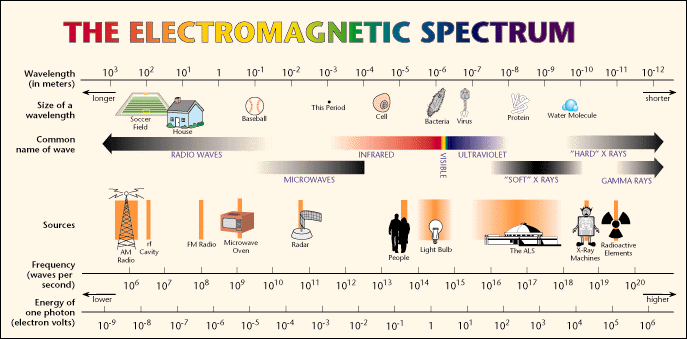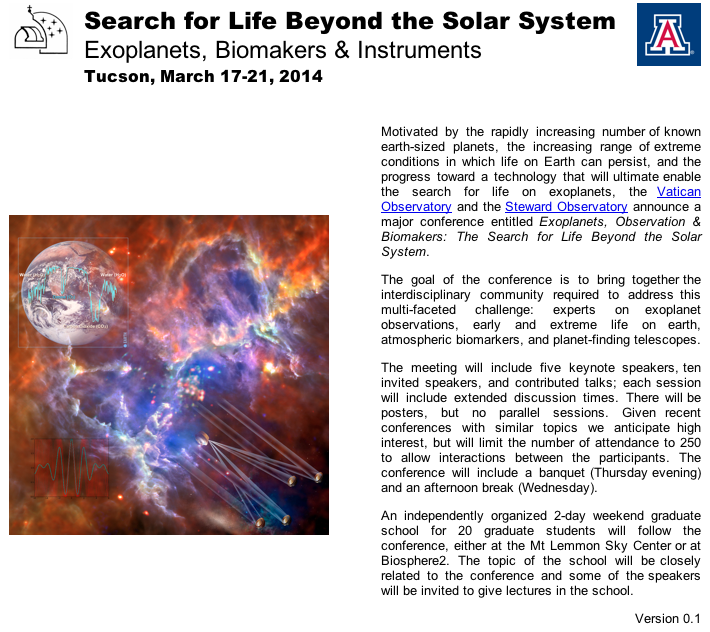It looks like you're using an Ad Blocker.
Please white-list or disable AboveTopSecret.com in your ad-blocking tool.
Thank you.
Some features of ATS will be disabled while you continue to use an ad-blocker.
share:
originally posted by: Blue Shift
originally posted by: game over man
Why don't you think we will find extremophiles in our Solar System?
We might, but we haven't yet, and we've already covered a lot of territory. This is one of those deals where there either is ET life in the Solar System, or there isn't. And the only way to prove it exists is to find it. Conjecture doesn't count. So far, we haven't found any, and it's not looking good.
You realized we haven't started looking? Curiosity is looking to see if the planet used to be habitable. Most spacecraft is looking for water. There is no extremophile mission currently.
originally posted by: ChaoticOrder
I'm sure by now most people have heard of the renewed search for ET intelligence. Essentially some billionaire seems to be funding a much more powerful version of the SETI program. While I don't think it's a total waste of money because it will yield important scientific data, I do think it's a waste of time to look for intelligent signals. This isn't just due to my personal opinion on the matter, there are many scientific reasons why the search is doomed to fail. To begin with radio signals will degrade as they propagate through space due to the inverse square law (the same reason a light bulb looks dimmer from a distance). After only a couple of hundred light years at most, any radio signals sent from Earth become indistinguishable from background noise. Even if there was intelligent life on one of the closest stars to us it would still be extremely difficult to detect any signal coming from their planet.
Except you do not realize there are several scientific problems with your criticism (i'd like to at this point apologize and say that i'm sorry for ruining your thread by dropping these points you overlooked in your original post quoted above but as an astronomer, i felt it necessary)
1. You assume the radio signals we are looking for must be sent to us for communication. This is a common but bad assumption and back in April of this year I posted on ATS about why is it a bad assumption here: ATS: Denying Ignorance About SETI: It's Not Just About Radio Anymore.
We ourselves send out many signals detectable at interstellar distances which have nothing to do with communication. The loudest of these is a planetary radar installation at Arecibo in Puerto Rico which is used to take radar images of things like potentially hazardous asteroids as they approach the Earth. Radio waves could also be the waste byproduct of some forms of interstellar propulsion systems, advanced industrial processes in another solar system, or bizarre technologies we've yet to invent.
Here's the relevant excerpt from that ATS post I made in April:
Mainstream media often reports that SETI has been searching the skies for over 50 years without detecting anything in the way of radio signals from extraterrestrial civilizations. Unfortunately such stories usually fail to mention the enormity of the task and just how little of the sky and frequency space has been covered:
As you can see from the above chart of various SETI experiments, Radio SETI over the last 55 years has not covered much in the way of frequency space nor has it examined the entire sky at high sensitivity.
So Radio SETI has a long way to go before anyone could say it's a waste of time in terms of covering every frequency and every part of sky at high sensitivity.
It should also be noted that most of the experiments on the chart above were short in duration, lasting weeks, months or a few years. It is not as though Radio SETI has been looking for signals around the clock 24/7 year after year. There were huge month and year-long gaps between observing runs.
Additionally we've only just begun doing SETI at the lower frequencies similar to what we use for radio and TV. Until now most SETI experiments operated in the microwave (above 1 Ghz) range. While most of our own radio leakage operates at lower frequencies. Enter LOFAR the massive, muilti-country, long frequency radio telescope array in Europe:
The Low Frequency Array feeds data to UC Berkeley's SETI@Home
Jocelyn Bell - Discoverer of the first 4 known pulsars (two of which were briefly labelled LGM-1 &LGM-2 for "Little Green Men") with one of the elements of the LOFAR array which conducts SETI experiments at frequencies similar to what we use for radio and TV. LOFAR is a precursor to the Square Kilometer Array
"But it's still radio duh....."
A more common criticism of Radio SETI has to do with the use of the word "radio". Most people hear radio and think of the thing in their car or the thing their parents used to listen to before the ubiquity of MP3 players, Pandora, and other streaming services.
It seems almost antiquated and counterintuitive in this day and age we'd be looking for advanced alien civilizations with something as old-fashioned as radio. After all, our own use of radio is vastly different today than it was in 1960s.
Unfortunately most people do not know that plenty of our technology today STILL uses radio, not just for communication either. Many of the same people also assume Radio SETI is looking for some form of communication when in reality all Radio SETI is looking to detect initially is a narrowband signal less than 1Hz wide. Such signals are not produced by nature but plenty of our technology produces them.
In fact Earth's most powerful radio signals are not for communication at all. They're not beaming entertainment and information in audio or video form (in the case of Broadcast TV).
Nope, our most powerful radio transmitter is the Arecibo Planetary Radar in Puerto Rico which is used to take radar images of near earth asteroids, especially ones which make close approaches.
Radar delay-Doppler images of asteroid 2014 HQ124 taken with the Arecibo planetary radar. The Arecibo Planetary Radar transmits up to 1 MegaWatt (1 MW) of power with an antenna gain of about 73.3 dB at 12.6 cm wavelength, resulting in an equivalent isotropically radiated power (EIRP) of roughly 20 TeraWatts (20,000,000,000,000 watts or 20,000,000 MW). Most commercial TV and radio stations have EIRPs far less (100,000-1,000,000 watts or 0.1-1.0 MW)
An extraterrestrial version of Arecibo with the same sensitivity as modern SETI receivers could detect Arecibo's planetary radar at a distance of 5,000 light years (ly).
An extraterrestrial version of our Square Kilometer Array (SKA), which is due to see first light in 2024 would be able to detect Arecibo's planetary radar at a distance of 40,000 ly - almost half the diameter of our Milky Way galaxy. The SKA in it's first building phase would also be able to detect an alien equivalent of our airport radars at a distance of 60 ly.
Radar is just one use of radio an advanced civilization might still use because of its ease and usefulness in detecting and imaging objects in the cold darkness of space. Other uses might include beaming power to space colonies using microwaves from off world solar power collectors or even using such collectors to propel a starship (See: Starwisp).
Which brings me to.....
edit on 22-7-2015 by JadeStar because: (no reason given)
2. In the event that such signals WERE actually targeted at us you assume any radio signal which we receive would have to be sent by a planet which
already received our own radio/TV/radar signals.
Bad assumption because our Earth has been broadcasting much bigger signals than all of our radio/TV/radar signals combined for far longer than we've had radio/TV/radar technology. In fact this signal existed even before we as humans or any advanced life existed. And it started being broadcast by our planet, not a hundred, or a thousand or even a million years ago but BILLIONS of years ago.
Coincidentally I just posted about this in another ATS thread toda before I came across yours here.
Here is the relevant excerpt:
So our planet Earth would be know to be alive to anyone who might be able to take an image of it with advanced space telescopes telescopes anywhere in our Milky Way galaxy. Our Earth's plant life has sent this signal out to an area of 2 BILLION light years (that's almost the distance to the next nearest galaxy, M31 aka Andromeda) so that 100,000 light year distance within our galaxy is a piece of cake.
Of course our Milky Way has areas where dust obscures stars but if advanced aliens can see our Sun with advanced telescopes there's a good chance they could spot our Earth and its natural "Hey guys, I'm Alive!" signal in the reflected sunlight bouncing off of our planet which enters their telescopes.
So at any time in the last 2 Billion years our Earth could have been entered into other intelligent species catalogs of interesting planets where life has occurred.
Because of our planets plant life it may have landed on any number of alien world's "Top 10 List".
It would then be a small matter for them (or even us) to set up an automated transmitter to beam signals periodically at any of these 'green worlds" while another super sensitive automated receiving facility looks for a reply.
If the alien species itself is post-biological as many believe we ourselves may soon be within the next 50-100 years then they effectively would be immortal and what's a million or even a billion years to a robot or an immortal species?
Not a lot and a reply might be worth waiting for.
But how would they detect such a reply you know, given the Inverse-Square law and all?
That brings me to my final critique.....
Bad assumption because our Earth has been broadcasting much bigger signals than all of our radio/TV/radar signals combined for far longer than we've had radio/TV/radar technology. In fact this signal existed even before we as humans or any advanced life existed. And it started being broadcast by our planet, not a hundred, or a thousand or even a million years ago but BILLIONS of years ago.
Coincidentally I just posted about this in another ATS thread toda before I came across yours here.
Here is the relevant excerpt:
As a scientist I don't think our planet is unknown if intelligent life is common in our Milky Way galaxy.
Here's why:
Earth has been around for 4.5 billion years and for the last 2 billion of those years, our Earth has been broadcasting that life existed here in terms of our plant life generating biosignatures. These biosignatures would be detectable with technology no greater than we are capable of today out to a spherical area of 300 light years.
That is an area encompassing an estimated 391,725 stars and an estimated 86,180 potentially habitable worlds.
So for the last 2 billion years, an alien astronomer within that 300 light year sphere with technology no greater than our own, looking at our planet with a sufficiently large space telescope would notice that something was filling our atmosphere with free oxygen.
That would stand out to any alien astronomers because oxygen is highly reactive and likes to combine with other elements to form things like carbon monoxide aka smog (CO), carbon dioxide (CO2), water vapor (H2O) and formaldehyde (CH2O).
So anyone with a sufficiently large space telescope looking at the Earth and seeing a huge spike of O2 (free oxygen) would know something is replenishing it and the only something which does that efficiently for planets like ours, as far as we know, is life. Specifically photosynthetic life (plants, trees, etc).
They'd see something like these:
So yeah, if they're out there they probably at least know our forests are here. Few scientists would argue that. Could they have sent a probe or come here in the past? Maybe. Few scientists would argue that either. Even Carl Sagan suggested we look for evidence of such ancient visitation in images and data returned from our exploration of our solar system.
The only thing most scientists would have an issue with are claims that they are coming here now or are actually here now. There's just nothing which can be examined by science today which would firmly establish that.
BTW: This workshop took place last year in Arizona co-sponsored by The Vatican Observatory:
Another took place this past April in Puerto Rico, one of many of this type these days. It's focus was also on detecting the telltale signs of life on Earthlike worlds in our neighborhood (that 300 light year area I mentioned above):
Personally, I were a smart alien on a planet 100 light years away looking at the Earth with a hyper-telescope capable of seeing something the size of a Honda Accord car I'd probably have seen enough from our year 1915 to stay as far away as possible and observe from the comfort of my own solar system. And in 30 years I and the rest of my alien world could watch World War II unfold.
So our planet Earth would be know to be alive to anyone who might be able to take an image of it with advanced space telescopes telescopes anywhere in our Milky Way galaxy. Our Earth's plant life has sent this signal out to an area of 2 BILLION light years (that's almost the distance to the next nearest galaxy, M31 aka Andromeda) so that 100,000 light year distance within our galaxy is a piece of cake.
Of course our Milky Way has areas where dust obscures stars but if advanced aliens can see our Sun with advanced telescopes there's a good chance they could spot our Earth and its natural "Hey guys, I'm Alive!" signal in the reflected sunlight bouncing off of our planet which enters their telescopes.
So at any time in the last 2 Billion years our Earth could have been entered into other intelligent species catalogs of interesting planets where life has occurred.
Because of our planets plant life it may have landed on any number of alien world's "Top 10 List".
It would then be a small matter for them (or even us) to set up an automated transmitter to beam signals periodically at any of these 'green worlds" while another super sensitive automated receiving facility looks for a reply.
If the alien species itself is post-biological as many believe we ourselves may soon be within the next 50-100 years then they effectively would be immortal and what's a million or even a billion years to a robot or an immortal species?
Not a lot and a reply might be worth waiting for.
But how would they detect such a reply you know, given the Inverse-Square law and all?
That brings me to my final critique.....
edit on 22-7-2015 by JadeStar because: (no reason given)
3. Lastly, you assume the Inverse-Square law limitations for us and our present receiving capability would be the same limitations for them. There is
no reason to assume this. We are both constantly developing ever more sensitive receiving technology and we know how to build transmitters which dwarf
anything we now have. there's just no need for them. Additionally the use of the gravitational lens around a star by placing a receiver there could
magnify weak undetectable signals to be very loud. It would do the same for any transmitter placed there.
Like I said, sorry if this pours cold water on your idea. You thought it out logically and came up with logical arguments but unfortunately did not have a complete picture beyond one very specific (and in my opinion fairly unlikely) contact scenario. I feel it would be far more likely that we detect the byproduct(s) of any nearby technological civilization than any intentional signal aimed us. It's a numbers game. Of all the forms of technology we use which produce detectable signals at interstellar distances only a very tiny amount are ever used for interstellar communication. I'd suspect the same would hold true for any aliens.
SInce SETI is not looking necessarily for communication but for ARTIFICIALITY among the stars then detecting weird radio byproducts of the alien trash compactor disposing of a planet around Beta Hydri works just as well from their perspective.
Like I said, sorry if this pours cold water on your idea. You thought it out logically and came up with logical arguments but unfortunately did not have a complete picture beyond one very specific (and in my opinion fairly unlikely) contact scenario. I feel it would be far more likely that we detect the byproduct(s) of any nearby technological civilization than any intentional signal aimed us. It's a numbers game. Of all the forms of technology we use which produce detectable signals at interstellar distances only a very tiny amount are ever used for interstellar communication. I'd suspect the same would hold true for any aliens.
SInce SETI is not looking necessarily for communication but for ARTIFICIALITY among the stars then detecting weird radio byproducts of the alien trash compactor disposing of a planet around Beta Hydri works just as well from their perspective.
edit on 22-7-2015 by JadeStar because: (no
reason given)
While I agree with the problem with radio signals, I hardly think SETI's anything close to being a waste of time. Really, our species dropping bombs
on each other over petty economical and religious differences is a waste of time. All of that energy can be better spent helping out each other and
furthering our progress as a species. That includes exploring space.
Heck, Optical SETI's come to age, which means our range in detecting the EM spectrum has grown even more. When I heard about that my enthusiasm for SETI pretty much returned, because unfortunately their focus had been pretty narrow and low for a while. Still, there'd likely be the random chance that someone will blow a whole lot of bandwidth on a signal out there and shock us (the Wow! comes to mind as an example of that possibly happening, although there's the equal chance that it was just an unidentified Earth-borne signal—the jury's still out on that). Then of course there's the matter of increasing the gain here (building bigger and bigger receivers—although, at what point do receivers become impractically huge and we need to consider other ideas?).
Then, considering Jade's dissertation on Radio SETI above, I may have to reconsider some of my own criticism about Radio SETI. I didn't consider the issue of our plant-life making noise.
Heck, Optical SETI's come to age, which means our range in detecting the EM spectrum has grown even more. When I heard about that my enthusiasm for SETI pretty much returned, because unfortunately their focus had been pretty narrow and low for a while. Still, there'd likely be the random chance that someone will blow a whole lot of bandwidth on a signal out there and shock us (the Wow! comes to mind as an example of that possibly happening, although there's the equal chance that it was just an unidentified Earth-borne signal—the jury's still out on that). Then of course there's the matter of increasing the gain here (building bigger and bigger receivers—although, at what point do receivers become impractically huge and we need to consider other ideas?).
Then, considering Jade's dissertation on Radio SETI above, I may have to reconsider some of my own criticism about Radio SETI. I didn't consider the issue of our plant-life making noise.
edit on 7/22/2015 by Kojiro because: (no reason given)
originally posted by: Kojiro
While I agree with the problem with radio signals, I hardly think SETI's anything close to being a waste of time. Really, our species dropping bombs on each other over petty economical and religious differences is a waste of time. All of that energy can be better spent helping out each other and furthering our progress as a species. That includes exploring space.
Heck, Optical SETI's come to age, which means our range in detecting the EM spectrum has grown even more. When I heard about that my enthusiasm for SETI pretty much returned, because unfortunately their focus had been pretty narrow and low for a while. Still, there'd likely be the random chance that someone will blow a whole lot of bandwidth on a signal out there and shock us (the Wow! comes to mind as an example of that possibly happening, although there's the equal chance that it was just an unidentified Earth-borne signal—the jury's still out on that). Then of course there's the matter of increasing the gain here (building bigger and bigger receivers—although, at what point do receivers become impractically huge and we need to consider other ideas?).
Then, considering Jade's dissertation on Radio SETI above, I may have to reconsider some of my own criticism about Radio SETI. I didn't consider the issue of our plant-life making noise.
Thank you.
One correction. The "noise" our plant life makes is not in the radio spectrum but in the spectra of light Earth reflects in the visible and infrared.
Anyone who can see our planet from a distance can tease out the fact that it has oceans, clouds and plant-life even if all they see is a tiny pale blue dot a pixel or few pixels wide.
edit on 23-7-2015 by JadeStar because: (no reason given)
a reply to: Blue Shift
The problem I have with those types of theories is, if it were true then would realizing it not cause some sort of glitch or something ?
The problem I have with those types of theories is, if it were true then would realizing it not cause some sort of glitch or something ?
It is my hypothesis that there are civilizations in our galaxy capable of sending out radio signals, but they're so far apart we won't ever hear from
anyone else, at least in the near future. More advanced civilizations would have developed some sort of more advanced, or more all-encompassing,
communication method.
originally posted by: VoidHawk
originally posted by: Bedlam
originally posted by: VoidHawk
Concerning the radio signals. The inverse law may only apply to us because we dont yet have the ability to overcome it.
Not so much. It's basic radio physics.
from our perspective!
Consider what the laser did for light transmission!
You're both right.
Bedlam's right in that the inverse square law is true for any electromagnetic waves or rays for example, visible light, radio waves, microwaves, infrared and ultraviolet light, x rays, and gamma rays.
As it is a physical law it is is universal so the same law which applies to us would apply to a species on a planet circling the star Tau Ceti.
VoidHawk is right in pointing out that the impact or effect of the inverse square law on the detectability of any sort of signals over interstellar distances is best determined by the technology on both ends of the signal path.
That's to say that it's both a function of the transmitter strength (he pointed out what the invention of the laser did for communication with light as compared to say, a light house beacon) and receiver sensitivity (how weak a signal a receiver can pick up on a particular frequency and bandwidth).
In the SETI scenario in the original post the aliens presumably control the transmitter power and there is no reason to believe that they would be limited to what our largest transmitters put out here. They might easily have created huge solar powered phased arrays of microwave transmitters for things like beaming power things in the outer part of their planetary system or even propelling an interstellar probe or starship. These transmitters would be louder than anything Earth produces.
And as I mentioned above, the receivers used for SETI are extremely sensitive and getting more sensitive all the time. So the ability to find weak signals in what would sound to you and me like random noise is increasing every 2 years due to Moore's law. Why would a law effecting computer processing power affect SETI sensitivity? Because SETI software uses integration times of many minutes on the various channels it monitors. This signal integration is done using CPU power and allows very weak narrow (and therefore artificial) signals to be built up or teased out of the noise bed.
This is quite different than the instant way our radios pick up signals. It doesn't matter because SETI is not trying to listen to the alien Top 10 chart or watch their version of reality TV. It's just looking for a spike that would be narrow enough that nature could not have made it therefore: aliens.
So while the Inverse-Square Law is important for any sort of signal transmission and reception how it affects SETI depends on an unknown (alien transmitter power) and a constantly increasing factor (our receiving sensitivity).
The Inverse-Square Law therefore is a false argument against SETI since it only looks grim from the point-of-view of a very limited scenario. And without knowing what the aliens have at their disposal any argument using it against SETI is based on an assumption of alien transmitting limitations mirroring our own at present.
edit on 23-7-2015 by JadeStar because: (no reason given)
originally posted by: JadeStar
That is an area encompassing an estimated 391,725 stars and an estimated 86,180 potentially habitable worlds.
Do you find this number so big that it guarantees advance life? When we look at earth we see a perfect planet that has had trillions of life forms and only one in 4.5 billion years to reach the level to have intelligence and the physical capabilities to do something with that intelligence. I would also suggest that out of your 86k planets you most likely would have an extremely low chance for a perfect earth type and you would see more along the ranges of Mars or Venus as "habitable worlds". I think most agree that when conditions are right life happens, but advance life is much more restricted to what range a habitable planet would need to be within for it to have a chance to evolve from simple lifeforms.
I would suggest that out of even 100s of millions of habitable worlds the chances for advance intelligent life with the physical capabilities needed to build as you suggest are still extremely small.
I could take this a different way. I could suggest life in general and have a good chance we would find it one day, but if I suggested a purple flying hippo with yellow spots that weighted 10,000 pounds the chances become far less as I add more and more discriminators to what kind of life I am looking for. Well to say advance intelligent, physically capable to build etc is basically saying the same thing as my purple hippo, and with about as much chance to find too.
The main problem is not that we are not detectable, but that there is no one close enough to detect us...
originally posted by: xxThothxx
It is my hypothesis that there are civilizations in our galaxy capable of sending out radio signals, but they're so far apart we won't ever hear from anyone else, at least in the near future. More advanced civilizations would have developed some sort of more advanced, or more all-encompassing, communication method.
It is suggested that omni radio waves spans of 150 years before the development of focused closed systems that do not escape.
originally posted by: Xtrozero
originally posted by: JadeStar
That is an area encompassing an estimated 391,725 stars and an estimated 86,180 potentially habitable worlds.
Do you find this number so big that it guarantees advance life?
Nope. Nothing will guarantee advanced life other than finding it.
Probabilistic arguments in support of (or against) the ubiquity of even basic life much less advanced life have a profound lack of data. Once we have confirmation of simple and/or advanced life on another planet then probabilistic arguments will have more weight since we could estimate the probability of us making the detection of that life and start extrapolating from there. Each new detection of life elsewhere would make such extrapolation more accurate.
As it is today, anything beyond simply saying "there would seem to be a lot of really good places where life as we know it could form" is still more guesswork and speculation than science.
That all changes the moment we find so much as a microbe on another world and REALLY changes if we find evidence of a present or extant civilization elsewhere in the galaxy or universe.
When we look at earth we see a perfect planet that has had trillions of life forms and only one in 4.5 billion years to reach the level to have intelligence and the physical capabilities to do something with that intelligence.
Yes and our planet is relatively young. Most stars and planets in our galaxy are older than ours by billions of years. We're more likely to be closer to the little kids table than the adult table. In other words, if given the same time scale it took for life to evolve on Earth, many of these other planets could be roughly where we are now at the time our Solar System formed.
I would also suggest that out of your 86k planets you most likely would have an extremely low chance for a perfect earth type
True, but that doesn't mean that bunch, perhaps even a majority (who knows?) wouldn't be perfect for the type of life which is indigenous to them.
There is no reason to believe Earth the most habitable type of planet in the galaxy.
In factthere are studies which indicate there should be "superhabitable planets" out there even more lush and beautiful than Earth but perhaps circling stars very different from out Sun, or perhaps a moon of a giant planet (ala Pandora in Avatar).
and you would see more along the ranges of Mars or Venus as "habitable worlds".
Did you know there is a whole range of terrestrial type worlds possible between the extremes of Mars and Venus?

I mean, we like to use them as extreme because they are familiar to us but the three possibilities of a planet like Mars, Earth and Venus are not anywhere near the full range nature may have conjured up so it is quite possible for a terrestrial world to be habitable but not a Class M planet like our Earth yet not the extremes of a Class T planet like Venus or a Class hP planet like Mars.

The most fascinating thing is we have no idea what those worlds in the middle of those extremes might be like or what if anything could inhabit them. For example one can imagine snowy Class P planets which are not as warm as Earth but not cold dry deserts like Mars (think Hoth from Star Wars or Delta Vega from Star Trek). What kind of life could exist on those? We don't know.
That's why this field is so exciting. It's like we're at the beginning of learning just what if anything grows on the planets around neighboring stars and by extension, perhaps how likely it is that we'd encounter another technological civilization.
I think most agree that when conditions are right life happens, but advance life is much more restricted to what range a habitable planet would need to be within for it to have a chance to evolve from simple lifeforms.
I feel that given enough time and the right conditions any form of life if sufficiently tested by its environment may become advanced. That doesn't mean building cities and space ships. That simply means more advanced than single celled, microbial life. Of course that is a guess with out data. Speculation with nothing to support it but our lone example: Earth.
Where it goes from there would be even more speculative but it's worth a try to search for things which we know are detectable which it might produce.
I would suggest that out of even 100s of millions of habitable worlds the chances for advance intelligent life with the physical capabilities needed to build as you suggest are still extremely small.
You would be suggesting that based on no data. We simply don't know. There's no shame in saying that. You could be right. Or Gene Roddenberry could be right. Or some combination of the two. We simply at this point don't know. We might know within our lifetime though (if you're not too old).
I could take this a different way. I could suggest life in general and have a good chance we would find it one day, but if I suggested a purple flying hippo with yellow spots that weighted 10,000 pounds the chances become far less as I add more and more discriminators to what kind of life I am looking for. Well to say advance intelligent, physically capable to build etc is basically saying the same thing as my purple hippo, and with about as much chance to find too.
Which is why I said probabilistic arguments without enough data are not very convincing on their own. One of the misunderstandings about the Drake Equation for example is that it was designed as a probabilistic argument. It was never intended to be used that way it was created to break the problem of detecting technological life in our galaxy into a series of smaller questions which specific observations or instruments could address.
I've pointed this out in another thread.
Only when we have half decent numbers for the majority of factors in it (all but L) will we be able to say anything definitive about the preponderance or scarcity of technological life in our galaxy and universe beyond.
The main problem is not that we are not detectable, but that there is no one close enough to detect us...
And that would be guessing. That guess could be proven wrong tomorrow. All it takes is a few microbes here, the detection of a stray radio signal there suddenly our corner of the universe would look a lot different.
One can not use a guess, speculation or probabilistic argument to come to a conclusion about questions as important as these without adequate data. Things like exoplanet studies, astrobiology and SETI are fields and experiments to gather data which help constrain the possibilities to zoom in on not what is probable but what is likely. And by investigating what is likely we further rule in or out possibilities and tighten the focus to eventually make the "OMG!@" discoveries.
But all that requires data... so even though the science parody video below is from another field of science (neuroscience) astronomers are often up all night to get data too
edit on 23-7-2015 by JadeStar because: (no reason given)
I always wondered why radio waves, if the ET's evolved differently wouldn't their means of communication differ, and what if they are far more
advanced, wouldn't they look for a signal much like their own, our tech would be useless, perhaps that's why we haven't gotten any signals all
together,
originally posted by: greenfox86
I always wondered why radio waves, if the ET's evolved differently wouldn't their means of communication differ
Because the laws of physics are the same throughout the universe and that includes electromagnetism and the electromagnetic spectrum which radio is a small part of.

All of the various waves and rays are just different frequencies of light. Radio is no exception. The divisions we make in the electromagnetic spectrum usually have to do with differences in the properties of this light. For instance, visible light is stopped by an (non-transparent) object while radio light travels around it and x-ray and gamma ray light travel through.
An alien species aware of electromagnetism would also notice these differences because it doesn't matter where they are the same laws and properties are consistent everywhere.
So... Suppose a species evolved laser communication rather than radio first. They might not use radio to communicate at all and only use it for things like radar or heating up their equivalent of food. But... if they are sufficiently curious they might wonder if someone else out there is using radar or even using it to communicate just as we have started looking for laser signals.
and what if they are far more advanced, wouldn't they look for a signal much like their own, our tech would be useless, perhaps that's why we haven't gotten any signals all together,
Not necessarily. Suppose we in the future discover some superior, near instantaneous form of communication not involving electromagnetism at all. Lets call it Q-Communication or Q-Com for short.
Well even if we had Q-Com we (or our cyborg and AI descendants) might still look for radio and send out radio to make contact with civilizations which are not at their technological level.
If such a species is curious (science and technology are based on and the result of curiousity) then its reasonable to think they might do this for the similar reasons we contact isolated peoples in parts of the world which aren't as technologically advanced.
So while we would continue sending selfies to our friends on other planets elsewhere in our neighborhood galaxy and watching Season 398 of "Keeping up with the Cardassians" (please make it stop) on our Q-Com devices, our AI puts a note in the database next to that blue dot circling a still un-named dim yellow-orange star which notes that artificial (narrow band) radio signals have been detected there perhaps as a result of a "primitive" civilization and writes a paper about it in the Astrophysical Journal.
edit on 23-7-2015 by JadeStar because: (no reason given)
In the event we do detect a series of signals bouncing around within the EM spectrum, and conclude the source is likely “intelligent” (even if
we’re unable to understand the contents), then what? Well, for one thing it will at least tell us we are unlikely to be alone. This knowledge in
itself would serve as validation that we’re at least focussing our efforts in a direction that may someday reap rewards. This, in turn, would
justify funding further scientific inquiry through related research. This would be a good thing.
I may be way offbase here, but I have a feeling that if we ever do detect signs of intelligence in the form of EM waves, it may be a clue that it was generated by an intelligence at a level not that much greater than our own. I say this because as good as EM radiation has been for us at carrying information, it’s severely limited as a means of communication on an interstellar scale. I imagine that any truly advanced intelligence would require another carrier. Something we’re not aware of yet. That’s OK, though, since I doubt we could communicate with it anyway; it would be like a conversation between Albert Einstein and a bucket of pond slime.
Even so, knowing that we’re not alone would still be a major discovery. Although the huge distances would preclude any meaningful conversation, it would still be good to know if there are other monkeys in the playground.
Although I won’t be holding my breath awaiting news that we’re not alone, I wish them the best at their endeavor. It’s a step in the right direction.
BTW, I think it's a cryin' shame that NASA is not funded adequately by our government. I wish they'd bump up the budget by at least 4 or 5 times. It's one of the few noble endeavors of our species; too bad it's not valued more.
Have fun!
I may be way offbase here, but I have a feeling that if we ever do detect signs of intelligence in the form of EM waves, it may be a clue that it was generated by an intelligence at a level not that much greater than our own. I say this because as good as EM radiation has been for us at carrying information, it’s severely limited as a means of communication on an interstellar scale. I imagine that any truly advanced intelligence would require another carrier. Something we’re not aware of yet. That’s OK, though, since I doubt we could communicate with it anyway; it would be like a conversation between Albert Einstein and a bucket of pond slime.
Even so, knowing that we’re not alone would still be a major discovery. Although the huge distances would preclude any meaningful conversation, it would still be good to know if there are other monkeys in the playground.
Although I won’t be holding my breath awaiting news that we’re not alone, I wish them the best at their endeavor. It’s a step in the right direction.
BTW, I think it's a cryin' shame that NASA is not funded adequately by our government. I wish they'd bump up the budget by at least 4 or 5 times. It's one of the few noble endeavors of our species; too bad it's not valued more.
Have fun!
a reply to: netbound
How do we define intelligent signals? Every signal that comes in from everywhere contains information about it source. By that definition then everything that comes in from the observed Universe contains information that is intelligent. Just because it happens that self aware individuals sent it, it would contain information purely subjective to their paradigm. Which we wouldn't have a hope in Hades of understanding, because we are looking at it from our perspective. Therefore all signals that we don't understand could be alien in origin. So really we have to look for signals that don't make sense, surely a bit of a paradox, when searching for alien life..
How do we define intelligent signals? Every signal that comes in from everywhere contains information about it source. By that definition then everything that comes in from the observed Universe contains information that is intelligent. Just because it happens that self aware individuals sent it, it would contain information purely subjective to their paradigm. Which we wouldn't have a hope in Hades of understanding, because we are looking at it from our perspective. Therefore all signals that we don't understand could be alien in origin. So really we have to look for signals that don't make sense, surely a bit of a paradox, when searching for alien life..
a reply to: anonentity
Mathematical repetition indicating artificiality is pretty much what SETI scientists are looking for. If there's a definite, artificial structure to the signal, we can pretty much determine that it's "intelligent." This is why, when first discovered, pulsars had scientists initially excited and intrigued.
Mathematical repetition indicating artificiality is pretty much what SETI scientists are looking for. If there's a definite, artificial structure to the signal, we can pretty much determine that it's "intelligent." This is why, when first discovered, pulsars had scientists initially excited and intrigued.
new topics
-
Gov Kristi Noem Shot and Killed "Less Than Worthless Dog" and a 'Smelly Goat
2024 Elections: 44 minutes ago -
Falkville Robot-Man
Aliens and UFOs: 58 minutes ago -
James O’Keefe: I have evidence that exposes the CIA, and it’s on camera.
Whistle Blowers and Leaked Documents: 1 hours ago -
Australian PM says the quiet part out loud - "free speech is a threat to democratic dicourse"...?!
New World Order: 2 hours ago -
Ireland VS Globalists
Social Issues and Civil Unrest: 2 hours ago -
Biden "Happy To Debate Trump"
Mainstream News: 3 hours ago -
RAAF airbase in Roswell, New Mexico is on fire
Aliens and UFOs: 3 hours ago -
What is the white pill?
Philosophy and Metaphysics: 5 hours ago -
Mike Pinder The Moody Blues R.I.P.
Music: 5 hours ago -
Putin, Russia and the Great Architects of the Universe
ATS Skunk Works: 8 hours ago
top topics
-
A Warning to America: 25 Ways the US is Being Destroyed
New World Order: 13 hours ago, 21 flags -
Biden "Happy To Debate Trump"
Mainstream News: 3 hours ago, 7 flags -
Mike Pinder The Moody Blues R.I.P.
Music: 5 hours ago, 7 flags -
What is the white pill?
Philosophy and Metaphysics: 5 hours ago, 5 flags -
Australian PM says the quiet part out loud - "free speech is a threat to democratic dicourse"...?!
New World Order: 2 hours ago, 5 flags -
James O’Keefe: I have evidence that exposes the CIA, and it’s on camera.
Whistle Blowers and Leaked Documents: 1 hours ago, 5 flags -
RAAF airbase in Roswell, New Mexico is on fire
Aliens and UFOs: 3 hours ago, 4 flags -
Ireland VS Globalists
Social Issues and Civil Unrest: 2 hours ago, 4 flags -
Putin, Russia and the Great Architects of the Universe
ATS Skunk Works: 8 hours ago, 3 flags -
Falkville Robot-Man
Aliens and UFOs: 58 minutes ago, 1 flags
active topics
-
Gov Kristi Noem Shot and Killed "Less Than Worthless Dog" and a 'Smelly Goat
2024 Elections • 18 • : StoutBroux -
Re-election Tactic - JOE BIDEN Hints He May Put Books in the Homes of Black People.
2024 Elections • 30 • : WeMustCare -
Candidate TRUMP Now Has Crazy Judge JUAN MERCHAN After Him - The Stormy Daniels Hush-Money Case.
Political Conspiracies • 802 • : Threadbarer -
Australian PM says the quiet part out loud - "free speech is a threat to democratic dicourse"...?!
New World Order • 3 • : Athetos -
Biden "Happy To Debate Trump"
Mainstream News • 35 • : WeMustCare -
University of Texas Instantly Shuts Down Anti Israel Protests
Education and Media • 297 • : cherokeetroy -
-@TH3WH17ERABB17- -Q- ---TIME TO SHOW THE WORLD--- -Part- --44--
Dissecting Disinformation • 699 • : Thoughtful3 -
Putin, Russia and the Great Architects of the Universe
ATS Skunk Works • 25 • : SchrodingersRat -
Ditching physical money
History • 22 • : StudioNada -
Falkville Robot-Man
Aliens and UFOs • 3 • : KKLOCO











